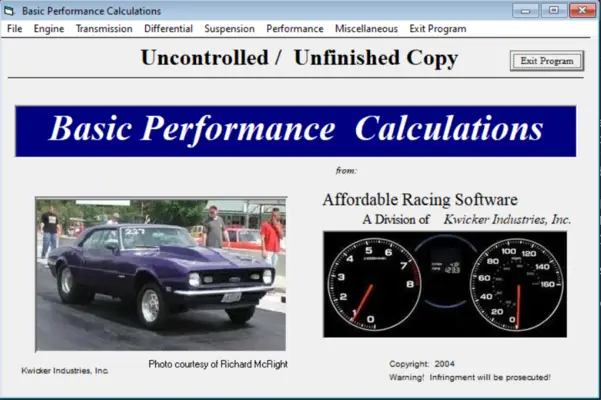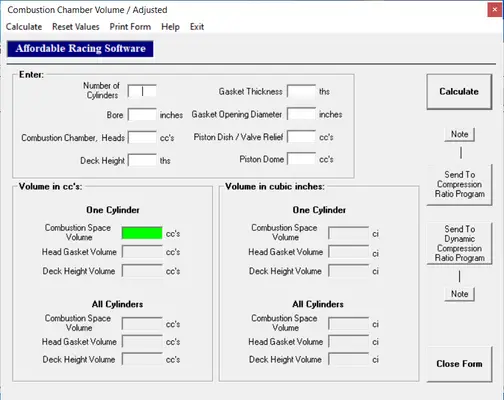I learned to write some VB6 code in my early 50s (about 20 years ago) and when I got to be an advanced beginner, I started a progam called "Basic Performance Calculations".
I got pretty far into it and then life (mostly wife, kids and work) got complicated and I put the project on the shelf. (I posted some pics of what it could do when i stopped working on it) Anyway, I retired and life has slowed down enough so that I have started working on the program again. In the meantime, my understanding of many things "Hot Rod" has expanded to where I see that some of what I put in the program needs a more detailed or complete explanation. I have also come across a lot more content I would like to include in the program.
Anyway, a couple of weeks ago, I started going throught the program from the beginning, making sure that the content was accurate and understandable. So one of the very first things I originally put in the program was a way to calculate Volumetric Efficiency and from that approximate Carburator Sizing for a given engine air capacity. My original results were based on info I found in performance mags, which it turns out is complete "ca ca". It is much more complicated than Car Craft and Hot Rod made it out to be 20 years ago.
So, in the process trying to gain a better understanding, I have been reading people who really know wtf they are talking about (mostly big buck racers). As you might expect, opinions vary but all agree on the physics involved. Having been on this forum for a long time, I know we have some Smokin Aces who have probably forgotten more than I will ever understand and I will be posting questions about things I don't really get in the hopes that some of you can make me understand (at least better than I do at present).
So, the biggest thing I don't understand about VE is that some are saying that an engine can only have 100% VE (because the space available in the cylinder for the air/fuel is fixed). That by itself is true but I think that there are dynamic circumstances at play that can vary the VE, including to more than 100%. First of all, if I understand correctly, one atmosphere is the pressure used to determine VE. But I have heard it argued that valve opening and closing points, exhaust pulse scavenging, intake air temp, injected or inducted fuel rates and some other exotic factors that I have to look straight up to see go over my head, can contribute to calculating VE and I assume that somewhere in there change the calculation to something other than just the one atmosphere calculation.
I would really appreciate any replies, for or against that anyone might have. I would like to get this program complete enough so that people could use it their projects go a little faster and maybe, easier. I iwill be posting more pics as time allows.
I got pretty far into it and then life (mostly wife, kids and work) got complicated and I put the project on the shelf. (I posted some pics of what it could do when i stopped working on it) Anyway, I retired and life has slowed down enough so that I have started working on the program again. In the meantime, my understanding of many things "Hot Rod" has expanded to where I see that some of what I put in the program needs a more detailed or complete explanation. I have also come across a lot more content I would like to include in the program.
Anyway, a couple of weeks ago, I started going throught the program from the beginning, making sure that the content was accurate and understandable. So one of the very first things I originally put in the program was a way to calculate Volumetric Efficiency and from that approximate Carburator Sizing for a given engine air capacity. My original results were based on info I found in performance mags, which it turns out is complete "ca ca". It is much more complicated than Car Craft and Hot Rod made it out to be 20 years ago.
So, in the process trying to gain a better understanding, I have been reading people who really know wtf they are talking about (mostly big buck racers). As you might expect, opinions vary but all agree on the physics involved. Having been on this forum for a long time, I know we have some Smokin Aces who have probably forgotten more than I will ever understand and I will be posting questions about things I don't really get in the hopes that some of you can make me understand (at least better than I do at present).
So, the biggest thing I don't understand about VE is that some are saying that an engine can only have 100% VE (because the space available in the cylinder for the air/fuel is fixed). That by itself is true but I think that there are dynamic circumstances at play that can vary the VE, including to more than 100%. First of all, if I understand correctly, one atmosphere is the pressure used to determine VE. But I have heard it argued that valve opening and closing points, exhaust pulse scavenging, intake air temp, injected or inducted fuel rates and some other exotic factors that I have to look straight up to see go over my head, can contribute to calculating VE and I assume that somewhere in there change the calculation to something other than just the one atmosphere calculation.
I would really appreciate any replies, for or against that anyone might have. I would like to get this program complete enough so that people could use it their projects go a little faster and maybe, easier. I iwill be posting more pics as time allows.
Attachments
Last edited:









